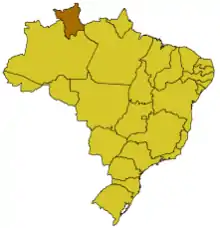Lavradeiro
The Lavradeiro or Roraima Wild Horse (in Portuguese: cavalo lavradeiro) is a feral horse that inhabits the savannah region of Lavrado in the northeast of the state of Roraima, in Northern Brazil.[1] It is considered one of the main symbols of the state and is one of the last populations of wild horses in the world, currently at risk of extinction.[1]
 | |
| Other names | Roraima wild horse, Roraiman horse, Lavradeiro horse, cavalo lavradeiro |
|---|---|
| Country of origin | Brazil |
| Traits | |
| Distinguishing features | Strong despite low-nutrition diet, fast and immunologically resistant |
In 1997, the Brazilian Agricultural Research Corporation (Embrapa) in Roraima started a herd of plough horses to study and preserve the breed, which still persists today.[2][3][4][5][6]
The breed originated from abandoned horses that descended from European horses (notably the Garrano and the Andalusian horse) brought to the region by the Portuguese in the 18th century.[1][5] After centuries of natural selection, horses of the breed have developed morphological and genetic characteristics that provided high resistance to common diseases and parasites in the region. There is also considerable participation of the thoroughbred in the origins of the breed since Roraima borders Guyana, formerly British Guiana, a colony of England.[7]
Features
According to data from 1993, the average height recorded in females is 1.37 m (4.5 ft), compared to 1.41 m (4.6 ft) in males. The average chest circumference is 1.63 m (5.3 ft) to 1.66 m (5.4 ft).[8] The Delachaux guide (2014) cites an average of 1.40 m (4.6 ft).[9]
The head is surmounted by small ears.[9] The back is short and the croup has a slight inclination. Mane and tail are hairy and very thick. The coat is generally bay, chestnut, iron grey or roan.[9] Lavradeiro has been the subject of studies on its blood proteins and on its RAPD markers.[10]
The breed is known for its excellent resistance to equine infectious anaemia.[8] It also has an optimal adaptation to its biotope and very good fertility. Therefore, it's potential as an animal genetic resource is recognised.[8] These horses are reputed to be intelligent, and docile once broken in.[9]
Distribution

The Lavradeiro is classified as a Brazilian breed locally adapted to the local biotope, in the DAD-IS1 database.[11] The Lavradeiro is unique to the state of Roraima, in Northern Brazil.[1]
In 1992, 1,200 Lavradeiros were listed in Brazil, with a downward trend; there is a management and conservation program for the breed. In particular, germplasm is conserved under the supervision of Embrapa in Roraima, for research purposes. In 2010, the population of Lavradeiro horses was between 1,260 and 1,680 individuals. No threat level is reported for this breed in the DAD-IS1.[11]
References
- "Raça: Lavradeiro" (in Brazilian Portuguese). Retrieved 2023-01-09.
- "Pesquisa investe na conservação do cavalo lavradeiro de Roraima". Revista Horse - Tudo sobre cavalo (in Portuguese). Retrieved 2023-01-09.
- "Revista Pesquisa Fapesp". revistapesquisa.fapesp.br. Archived from the original on 2023-01-08. Retrieved 2023-01-09.
- "Cavalos selvagens de Roraima". Meu Haras.
- "Genética do cavalo lavradeiro vai ser estudada no Brasil". www.dn.pt (in Portuguese). 10 May 2009. Retrieved 2023-01-09.
- "Embrapa e instituições parceiras investem na conservação do cavalo lavradeiro de Roraima". www.noticiasagricolas.com.br (in Brazilian Portuguese). Retrieved 2023-01-09.
- "Lavradeiro – o cavalo selvagem brasileiro na Amazônia". Multicavalos.
- Reunion Tecnica Sobre la Conserdacion Para El Desarrollo (in Spanish). Bib. Orton IICA / CATIE. 1993. p. 36.
- Rousseau, Élise (2014). Tous les chevaux du monde : près de 570 races et types décrits et illustrés (in French). Yann Le Bris. Paris: Delachaux et Niestlé. p. 506. ISBN 978-2-603-01865-1. OCLC 899366894.
- Mariante, Arthur da Silva; Egito, Andréa Alves; Albuquerque, Maria do Socorro Maués; Paiva, Samuel Rezende; Ramos, Alexandre Floriani (July 2008). "Managing genetic diversity and society needs". Revista Brasileira de Zootecnia. 37 (spe): 127–136. doi:10.1590/S1516-35982008001300016. ISSN 1516-3598.
- "Lavradeiro | Brazil horse". Domestic Animal Diversity Information System of the Food and Agriculture Organization of the United Nations (DAD-IS). Archived from the original on October 19, 2020. Retrieved September 28, 2018.